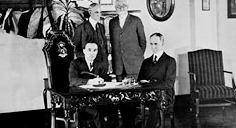When Cadillac’s owners refused to shift to warplane production to contribute to war efforts, Henry Leland resigned as president. The patriotic Leland and his son founded the Lincoln Motor Company in 1917, naming it after Abraham Lincoln, whom Leland greatly admired. The new company quickly set about building Liberty Aircraft engines for the U.S. military for World War I.

Leland’s Lincoln
When the government broke its contract earlier than expected, Leland decided to begin producing automobiles. Lincoln’s early successes were stunning—the company sold out of its vehicles within three hours of offering them for sale. But a series of economic circumstances created difficulties for the company, and by the early 1920s, the Lelands were seeking a buyer.
In 1922, Edsel Ford, attracted by Lincoln's high standards of quality, persuaded his father, Henry, to buy the company for $8 million. Lincoln became the first "outsider" to join the Ford family of vehicle brands and initiated the company's entrance into the luxury market.
Lincoln’s Craftsmanship Meets Ford’s Production Capacity
With the acquisition of Lincoln, the speed and capacity of Henry Ford's mass production techniques could now be applied without compromising the precision craftsmanship that Leland had advanced.
The early Lincolns of the 1920s represented Edsel's particular interests in vehicle design and aesthetics. These L-Series cars continued to use the Leland chassis. The K-Series cars of the 1930s had an updated chassis and often received bodies by prominent coachbuilders of the era.
Strictly Continental
A big breakthrough for the Lincoln brand came in 1938 when Edsel, inspired by a trip to Europe, commissioned his design team to create a car that would be "strictly continental" in design. With its sweeping lines and luxurious interiors, the first Continental Mark set the standard for Lincoln vehicles to come and became the ultimate status symbol as the nation entered the 1940s.
The 1940s also saw Lincoln, true to its patriotic roots, join the rest of Ford Motor Company in wartime production, manufacturing tank engines and jeep and amphibious vehicle bodies for the U.S. military.
A Luxury Symbol
After the war, Lincoln resumed its place as a luxury symbol. In 1951, the Museum of Modern Art in New York City chose Lincoln as one of only eight cars exhibited for "excellence as works of art."
In the second half of the 20th century, Ford Motor Company experimented with various division organizations involving Lincoln, building over time a close relationship between Lincoln and Mercury.
